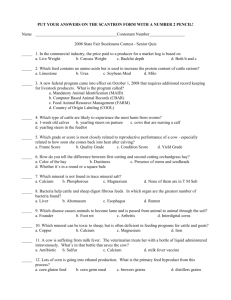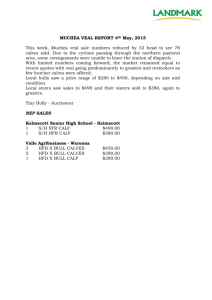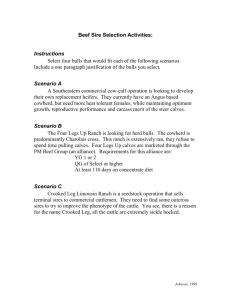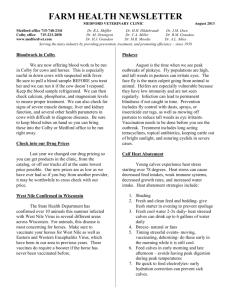'--L;->-- LESS REEF MORE
advertisement
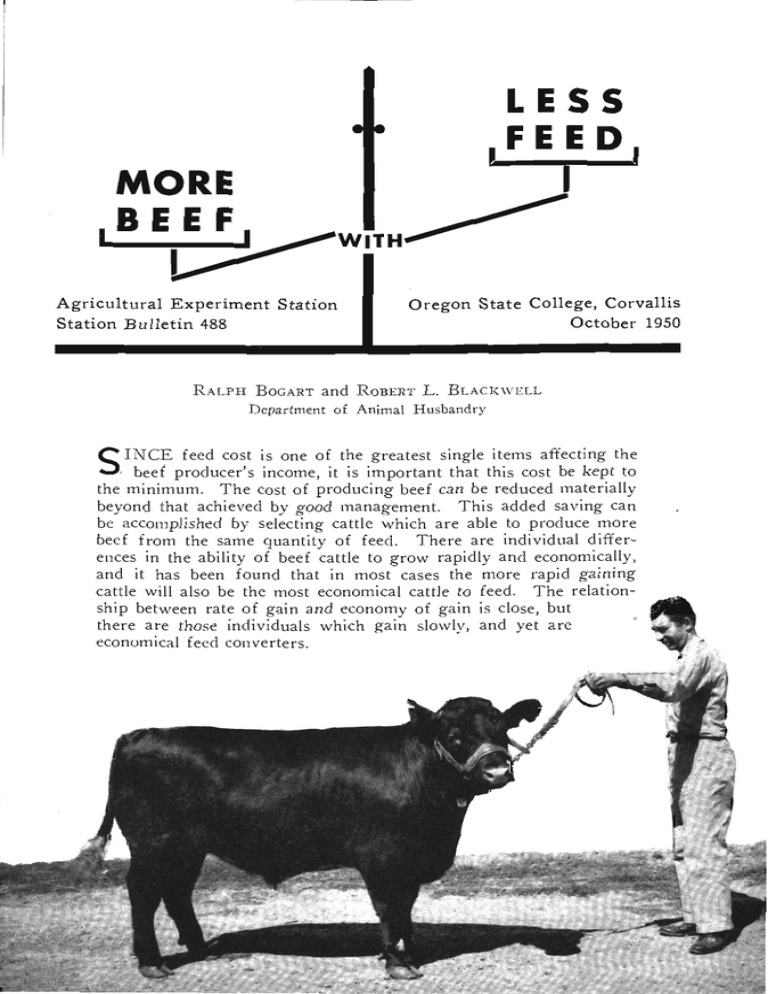
I LESS MORE REEF '--L;->-Agricultural Experiment Station Station Bulletin 488 W!TH Oregon State College, Corvallis I October 1950 RALPH BOGART and ROBERT L. BLAcK\VELL Department of Animal Husbandry feed cost is one of the greatest single items affecting the SINCE beef producer's income, it is important that this cost be kept to the minimum. The cost of producing beef can be reduced materially beyond that achieved by good management. This added saving can be accomplished by selecting cattle which are able to produce more beef from the same quantity of feed. There are individual differences in the ability of beef cattle to grow rapidly and economically, and it has been found that in most cases the more rapid gaining cattle will also be the most economical cattle to feed The relationship between rate of gain and economy of gain is close, but there are those individuals which gain slowly, and yet are economical feed converters. I The rate and economy of gain given in Table 1 are feeding results from twelve purebred Hereford and Angus bull calves of the same size that were fed individually. The total gain each calf made was 250 pounds and the initial weight of each calf was 550 pounds. When the twelve bull calves were divided into two groups on the basis of rate of gain, a considerable difference in the averages of the two groups became apparent. The faster gaining calves not only put on the gain of 250 pounds in less time, but it required 105 pounds less feed to make each 100 pounds of gain. Thus, for the gain of 250 pounds made by each calf there was a saving of 262 pounds of feed for the faster gaining calves over the slower gaining ones. This saving of feed was associated only with rate of gain because there was no difference in the size of the calves in the two groups In studies in which the same calves were observed during the feeding period, it was found that more feed was required to make each unit of gain as the calves became larger. Most breeders cannot feed individually to determine feed consumption, therefore reliance must be placed on rate of gain as a measurement of efficiency. If comparisons on rate of gain are made when the animals are the same size, the data will be dependable as an index of efficiency. The more rapid gaining cattle will generally be the most efficient. Table 1. DAILY GAIN AND FEED REQUIRED PER 100 POUNDS OF GAIN Feeding group Six fast gaining bull calves Six slow gaining bull calves Gain per day Feed required per 100 pounds gain Pounds Pounds 2.62 2.32 641 746 * The feed given was two parts chopped alfalfa hay to one part of grain mixture. Bulls Gain Fasfer and Require Less Feed Than Heifers The rate of gain and feed required per 100 pounds of gain was determined for 16 bulls and 16 heifer calves. (Table 2.) (Herefords and Angus.) The average daily gain was 2.34 pounds for the bulls The feed required for each 100 1.74 pounds for the heifers. pounds of gain was 791 pounds for the bulls and 1,056 pounds for the heifers. and This sex difference must be kept in mind in comparing cows or bulls on the basis of gains made by their calves. Comparisons can be made only when heifer calves of one bull or cow are compared with heifer calves of another cow or bull. Likewise bull calves by one bull or cow are to be compared only with bull calves from other bulls or cows. Table 2. RATE OF GAIN AND FEED REQUIRED PER 100 POUNDS OF GAIN OF HEIFERS AND BULLS Feeding group Gain per day Feed reciuired per 100 pounds gain* Pounds Pounds Sixteen bull calves Sixteen heifer calves 2.34 791 1.74 1,056 Feed Efficiency in Beef CaFfle Is Inherited The ability to grow rapidly and economically is passed on from generation to generation. Therefore, by selecting breeding stock for their ability to grow rapidly and economically, these characteristics may be established in a herd of beef cattle similar to the improvement that has been made in dairy herds for high milk production. The studies that have been made by the U. S. Range Livestock Station, Miles City, Montana, have shown that the bull or cow that grows rapidly and is efficient will generally produce calves that do likewise. This means that keeping the animals that gain faster will help to improve the herd for rate and economy of gains. In addition, bulls and cows that produce fast gaining and efficient calves have proved that they have the inherited ability for these traits. The use of such performance records on the calves in the culling of cows and bulls will speed up the improvement of beef cattle for efficient production. This type of culling (on the basis of the kind of offspring the bull sires or the cow raises) is known as progeny testing. In beef cattle, selection on the basis of how the individual animal gains during the period following weaning and the gains made by the offspring of this animal will make it possible for the breeder to improve his herd at the fastest possible rate for both rate and economy of gains. The kind of information given in Tables 1 and 2 is necessary to provide a basis for selection. Positive identification of the cattle throughout life and the family relationships are "musts" in a sound program of improvement for efficiency of feed utilization. How to Improve Your Herd Frequent weighing of the cattle while they are on feed will enable the feeder to find with considerable accuracy the time when the animals are approximately equal in size. A convenient weight range can be established such that all the cattle will be included in this weight range. From this, the rate of gain can be conveniently calculated by dividing the gain in weight in that range by the number of days required by each animal to make the gain. The calves gaining most rapidly can be located and culled or retained depending upon rate of gain and other characteristics that the breeder may want to consider. Also, the sires and dams of the fast gaining individuals can be determined and the grower can use this information to make decisions as to which bulls and cows to keep in the herd for further improvement. This form of improvement is progeny testing and has proved satisfactory as a means of improving productive characteristics in farm animals. Such a method is sound in principle and, when properly used in a breeding program, has been found to give the desired resultsproducing more beef from a given quantity of feed. Recommendations Identify each calf by some method so that a record of its birth date, sire, and darn can be kept. Obtain the weaning weight of each calf along with the date it was weaned. Feed or pasttlre so the animals can make good gains, but keep the ration practical by making use of forage and other roughages. Weigh frequently enough so that gains can be computed for all calves during a given period starting at comparable weights and gaining about the same total weight per calf. Keep for replacement breeding the calf that gains the fastest. Retain in the herd cows and bulls that produce faster gaining calves. Cull the slower gaining calves, also cows and bulls that produce slow gaining calves. Continue to select also for the characteristics you have always considered important. The selection for rate and economy of gains is not to be substituted for selection on the basis of type and conformation. This study was conducted in cooperation with Bureau of Animal Industry. United States Department of Agriculture and State Experiment Stations under Western Regional Project W.1 on Beef Cattle Breecing Research.



